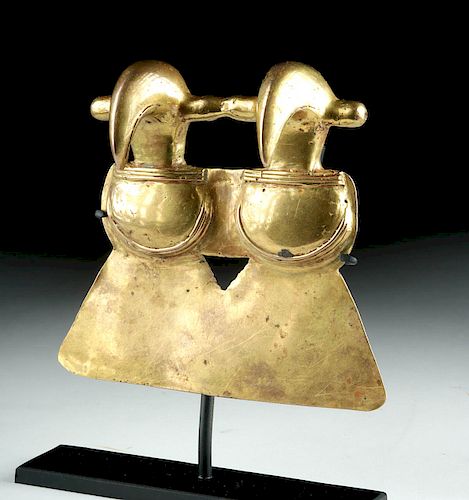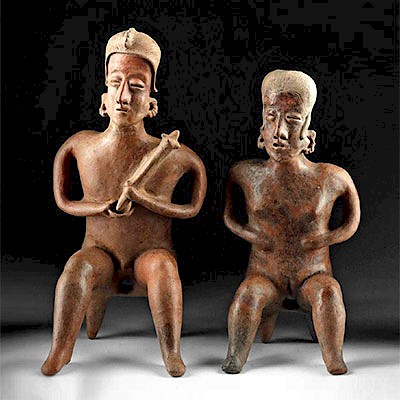Huge Panamanian Gold Double Bird Pendant - 166 g, TL
Lot 125
About Seller
Artemis Fine Arts
686 S Taylor Ave, Ste 106
Louisville, CO 80027
United States
Selling antiquities, ancient and ethnographic art online since 1993, Artemis Gallery specializes in Classical Antiquities (Egyptian, Greek, Roman, Near Eastern), Asian, Pre-Columbian, African / Tribal / Oceanographic art. Our extensive inventory includes pottery, stone, metal, wood, glass and textil...Read more
Estimate:
$30,000 - $45,000
Absentee vs Live bid
Two ways to bid:
- Leave a max absentee bid and the platform will bid on your behalf up to your maximum bid during the live auction.
- Bid live during the auction and your bids will be submitted real-time to the auctioneer.
Bid Increments
| Price | Bid Increment |
|---|---|
| $0 | $25 |
| $300 | $50 |
| $1,000 | $100 |
| $2,000 | $250 |
| $5,000 | $500 |
| $10,000 | $1,000 |
| $20,000 | $2,500 |
| $50,000 | $5,000 |
| $100,000 | $10,000 |
| $200,000 | $20,000 |
About Auction
By Artemis Fine Arts
May 23, 2019
Set Reminder
2019-05-23 10:00:00
2019-05-23 10:00:00
America/New_York
Bidsquare
Bidsquare : Exceptional Day 2 Ethnographic Tribal Fossils
https://www.bidsquare.com/auctions/artemis-gallery/exceptional-day-2-ethnographic-tribal-fossils-4136
Day 2 of an important 2-day auction featuring exceptional ethnographic art from around the world. Today's sale will feature Pre-Columbian from the ancient americas, Native American, African / Tribal, Oceanic, Spanish Colonial, and incredible Fossils. Artemis Fine Arts info@artemisgallery.com
Day 2 of an important 2-day auction featuring exceptional ethnographic art from around the world. Today's sale will feature Pre-Columbian from the ancient americas, Native American, African / Tribal, Oceanic, Spanish Colonial, and incredible Fossils. Artemis Fine Arts info@artemisgallery.com
- Lot Description
Pre-Columbian, Central America, Panama, Veraguas, ca. 1st to 5th century CE. Not one, but two conjoined birds grace this sizeable gold avian pendant! The gold quality is 52% to 65% (equivalent to ~ 14K+) on the front and 78% to 82% (equivalent to ~ 18K+) on the back. The eagles are nearly identical - with large heads presenting prominent curved beaks, rounded trapezoidal bodies outlined with triple linear borders, and grand triangular tail plumes. A masterful example of ancient Central American goldwork, quite rare for its double avian form! Gold quality: front: 52% - 65% (equivalent to ~ 14K+) back: 78% - 82% (equivalent to ~ 18K+). Size: 5" W x 4.625" H (12.7 cm x 11.7 cm); 6" H (15.2 cm) on included custom stand. Weight: 166 grams.
Central American avian pendants are perhaps the best known Precolumbian gold objects. Created to be suspended around the neck, they were made in various sizes, ranging from less than an inch in height to more than five inches. Single bird pendants are most common; double bird pendants like this one are more rare. Considered to be stylized representations of birds of prey with prominent beaks, scholars suggest that these pendants served as protective emblems.
According to "The Art of Pre-Columbian Gold: the Jan Mitchell Collection" catalogue, "Isthmian bird-form pendants were first called 'eagles,' aguilas, when Christopher Columbus sailed along Caribbean Central America in the early 1500s. Columbus and his men saw the bird pendants being worn about the neck by the peoples of the coast, in the manner of 'an Agnus Dei or other relic' (Colon, 1959). They named the pendants aguilas, a name they have kept to this day. In the present century, the generalized avian form of the pendants has given rise to much discussion over which type of bird is represented (see Cooke & Bray, this catalogue). Some authorities believe that the pendants depict birds of prey, thereby endorsing the Spanish name. The prominence of beaks and claws, and the various items held in their beaks, support such a view. . . Veraguas eagles are sharp-edged and clean of outline, particularly when compared to those of Chiriqui style with their rounded contours. Wings and tail are worked more laterally . . . Veraguas eagles are also often more elaborated around the head and hold fewer things in their beaks." (Boston: Little Brown and Company, 1985, p. 112).
Follow this link to see a similar example that was once in the Nelson A. Rockefeller collection and on loan to the former Museum of Primitive Art in New York from 1957 to 1978 - https://www.alamy.com/stock-image-double-eagle-pendant-date-1st-5th-century-geography-panama-culture-168264019.html
The clay in the recesses of this piece has been tested using thermoluminescence (TL) analysis and has been found to be ancient and of the period stated. A full report will accompany purchase.
Provenance: ex-Freye Family collection, Scottsdale, Arizona, USA, acquired at Parke Bernet, New York, New York, USA, acquired in the 1960s
All items legal to buy/sell under U.S. Statute covering cultural patrimony Code 2600, CHAPTER 14, and are guaranteed to be as described or your money back.
A Certificate of Authenticity will accompany all winning bids.
We ship worldwide and handle all shipping in-house for your convenience.
#145128A few minor casting flaws, nicks, and scuffs as shown. Clay in the recesses on versos of heads with one small hole drilled for TL testing in each. Otherwise very nice to say the least!Condition
- Shipping Info
-
All shipping is handled in-house for your convenience. Your invoice from Artemis Gallery will include shipping calculation instructions. If in doubt, please inquire BEFORE bidding for estimated shipping costs for individual items.
-
- Buyer's Premium



 EUR
EUR CAD
CAD AUD
AUD GBP
GBP MXN
MXN HKD
HKD CNY
CNY MYR
MYR SEK
SEK SGD
SGD CHF
CHF THB
THB














